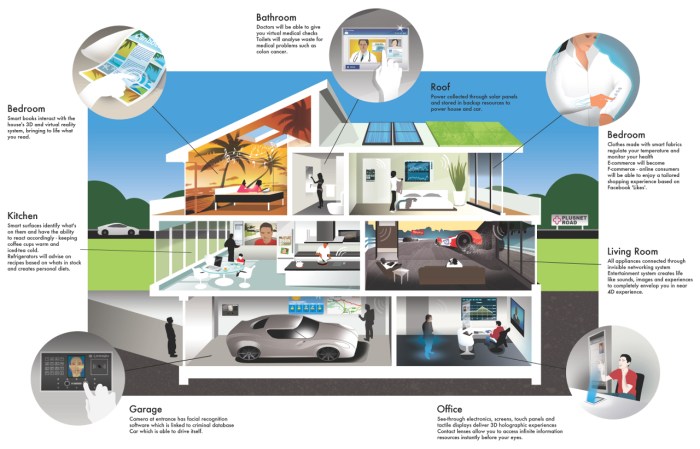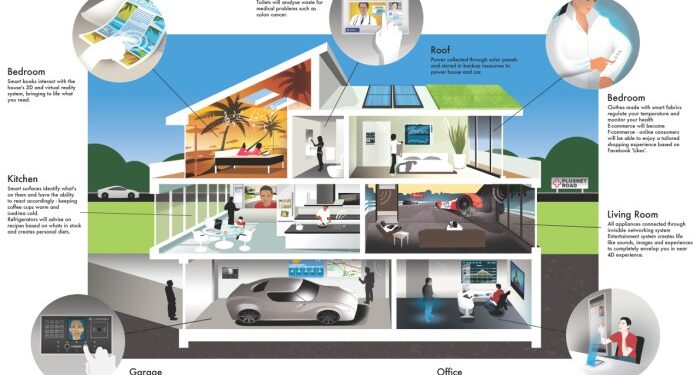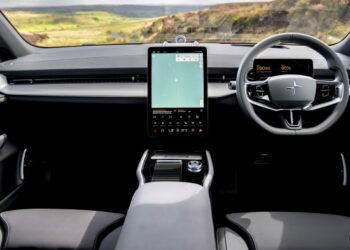Exploring the future of smart living and what it means for homeowners is a journey filled with innovative technologies and exciting possibilities. From AI integration to energy efficiency, this topic delves into the heart of modern living.
Detailing the key components and trends that shape the landscape of smart homes, this discussion aims to provide a comprehensive guide for those looking to embrace the future of home technology.
The Concept of Smart Living

Smart living refers to the integration of technology into our homes to enhance convenience, comfort, security, and efficiency. This concept involves using smart devices and systems to automate and control various aspects of our living environment.
How Smart Technology is Transforming the Way We Live
Smart technology has revolutionized the way we interact with our homes. From voice-controlled assistants like Amazon Alexa and Google Home to smart thermostats, lighting, security cameras, and appliances, these devices have made it possible to monitor and manage our homes remotely.
For example, homeowners can adjust the temperature, turn off lights, or even lock doors using their smartphones or voice commands.
Examples of Smart Devices Commonly Used in Smart Homes
- Smart Thermostats: Devices like Nest or Ecobee learn your preferences and adjust the temperature accordingly, saving energy and money.
- Smart Lighting: Systems like Philips Hue allow you to control the brightness, color, and scheduling of your lights through an app or voice commands.
- Smart Security Cameras: Cameras from companies like Ring or Arlo provide real-time monitoring and alerts for potential intruders or unusual activity.
- Smart Appliances: From refrigerators to washing machines, smart appliances can be controlled remotely, set on schedules, and even provide notifications for maintenance or repairs.
Benefits of Smart Living
Smart living offers numerous advantages for homeowners, making their lives more convenient, efficient, and sustainable.
Enhanced Convenience and Efficiency
- Remote access and control of home devices and systems, allowing homeowners to manage their homes from anywhere in the world.
- Automation of routine tasks such as adjusting lighting, temperature, and security settings, freeing up time for homeowners to focus on other activities.
- Integration of smart devices for seamless communication and coordination, streamlining daily operations within the household.
Energy Savings and Sustainability
- Smart thermostats and lighting systems optimize energy usage, reducing utility bills and environmental impact.
- Sensors and smart appliances monitor energy consumption and provide insights for more efficient usage patterns.
- Smart meters and energy management systems enable homeowners to track their energy usage in real-time and make informed decisions to conserve energy.
Key Components of a Smart Home
Smart homes are equipped with various key components that work together to create a connected and convenient living environment. These components include interconnected devices and systems that are controlled remotely for increased efficiency and comfort.
Interconnected Devices and IoT in Smart Homes
Interconnected devices play a crucial role in smart homes, allowing for seamless communication and automation. The Internet of Things (IoT) technology enables devices to connect and share data, leading to improved functionality and user experience. For example, smart thermostats can adjust the temperature based on your preferences and habits, while smart lighting systems can be programmed to turn on or off at specific times.
Popular Smart Home Systems and Their Functionalities
1. Amazon Echo
This voice-controlled smart speaker acts as a central hub for various smart home devices. With Alexa, the virtual assistant, users can control lights, thermostats, and other compatible devices through voice commands.
2. Google Nest
The Nest ecosystem includes smart thermostats, cameras, and smoke detectors that work together to provide a secure and energy-efficient home. Users can monitor and control these devices remotely using the Nest app.
3. Apple HomeKit
Compatible with a wide range of smart home products, HomeKit allows users to create scenes and automation based on their preferences. Users can control devices through Siri voice commands or the Home app.By integrating these key components into their homes, homeowners can enjoy the benefits of smart living, such as increased convenience, energy efficiency, and security.
Security and Privacy Considerations

In today's interconnected world, the security and privacy of smart homes have become a top priority for homeowners. With the rise of smart devices and IoT technology, it is crucial to understand the potential risks and take necessary precautions to protect your home and personal data.
Cybersecurity in Smart Homes
One of the most critical aspects of smart living is cybersecurity. Hackers can exploit vulnerabilities in smart devices to gain access to your home network, compromising your privacy and security. It is essential to invest in robust cybersecurity measures to prevent unauthorized access and protect your data.
Potential Vulnerabilities and Mitigation
- Weak Passwords: Using strong, unique passwords for each device and regularly updating them can help prevent unauthorized access.
- Outdated Software: Keeping all smart devices and software up to date with the latest security patches can mitigate the risk of exploitation.
- Unsecured Networks: Ensuring your home network is secure with encryption and firewall protection can prevent cyber attacks.
Protecting Privacy in Smart Living
Privacy is another crucial consideration in smart homes. With the amount of data collected by smart devices, it is essential to take steps to protect your privacy.
- Review Privacy Settings: Regularly review the privacy settings of your smart devices and adjust them to limit data collection and sharing.
- Secure Network: Implementing a secure network with strong encryption and setting up a separate guest network for visitors can help protect your privacy.
- Privacy Policies: Read and understand the privacy policies of the smart devices you use to know how your data is being collected and shared.
The Future Trends in Smart Living
As technology continues to advance, the future of smart living is poised to undergo significant transformations. With the integration of cutting-edge technologies such as AI and machine learning, smart homes are expected to become even more intuitive and efficient in the coming years.
Integration of AI and Machine Learning
- AI-powered Virtual Assistants: Virtual assistants like Amazon Alexa and Google Assistant will become more sophisticated, offering personalized recommendations and seamlessly integrating with various smart devices in the home.
- Predictive Maintenance: AI algorithms will enable smart home systems to predict when maintenance is needed for appliances, HVAC systems, or other devices, reducing the risk of unexpected breakdowns.
- Machine Learning for Energy Optimization: Smart homes will leverage machine learning algorithms to optimize energy consumption based on usage patterns, weather conditions, and electricity rates, leading to increased energy efficiency.
Evolution of Smart Homes in the Next Decade
- Enhanced Security Features: Smart homes will offer advanced security features such as facial recognition, biometric authentication, and AI-powered surveillance systems to provide homeowners with greater peace of mind.
- Health and Wellness Monitoring: Future smart homes will include sensors and devices that can monitor occupants' health metrics, detect anomalies, and provide insights for preventive healthcare measures.
- Sustainable Living Solutions: Smart homes will incorporate eco-friendly technologies like solar panels, smart water management systems, and energy-efficient appliances to promote sustainability and reduce environmental impact.
Ultimate Conclusion
As we conclude our exploration of smart living, it's clear that the future holds immense potential for homeowners seeking convenience, efficiency, and sustainability. The evolution of smart homes promises a lifestyle that is not only connected but also environmentally conscious.
Frequently Asked Questions
How can smart living enhance convenience for homeowners?
Smart living allows homeowners to control various aspects of their home remotely, leading to increased convenience in managing tasks and devices.
What are some examples of popular smart home systems?
Popular smart home systems include Amazon Alexa, Google Home, and Apple HomeKit, each offering unique functionalities for home automation.
How can homeowners protect their privacy in a smart living environment?
Homeowners can safeguard their privacy by ensuring strong passwords, regularly updating firmware, and being cautious about sharing personal information with smart devices.












